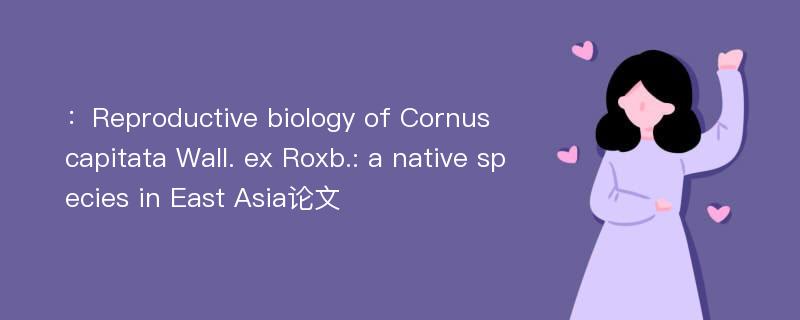
本文主要研究内容
作者(2019)在《Reproductive biology of Cornus capitata Wall. ex Roxb.: a native species in East Asia》一文中研究指出:The reproductive biology of Cornus capitata was studied in detail from June 2014 to October 2015 in Tehri Garhwal, Uttarakhand, western Himalaya, India and elucidated floral morphology, confirming autogamy, geitonogamy, and xenogamy. A new inflorescence ball formed each year with developing fruits that were initiated the previous year; thus reproduction is a continuous cycle. The total pollen production within a tree ranged between 4.0 × 10~7 and 9.3 × 10~7. Anthesis peaked between 08:00 and 10:00. There was significant effect of micro-environmental condition on anthesis(F = 243.8, p = 3.01). A significant positive relationship between the number of lateral shoots and total inflorescence showed that the inflorescence production in C. capitate depends largely on the number of lateral shoots. Time and concentration of various solutions significantly affected pollen germination(time: F = 5.39, p = 0.002; concentration: F = 1.40,p = 0.234). Anthophora bees and thrips were observed as the main pollinators. There was a significant difference in seed set between natural and obligate self-pollination(t = 11.84, p = 1.99). Significant effect was also observed on fruit size(t = 8.88, p = 2.09) between open and shaded conditions. SEM micrographs of pollen grains showed that the shape of dehydrated pollen grains differed greatly due to variations in the rate of dehydration among pollen grains within the anther. Seed germination was observed only in quality seed derived from open pollination, supporting xenogamy in C. capitata. Findings of the present study will be of immense value in formulating effective conservation measures for the species in wild habitats.
Abstract
The reproductive biology of Cornus capitata was studied in detail from June 2014 to October 2015 in Tehri Garhwal, Uttarakhand, western Himalaya, India and elucidated floral morphology, confirming autogamy, geitonogamy, and xenogamy. A new inflorescence ball formed each year with developing fruits that were initiated the previous year; thus reproduction is a continuous cycle. The total pollen production within a tree ranged between 4.0 × 10~7 and 9.3 × 10~7. Anthesis peaked between 08:00 and 10:00. There was significant effect of micro-environmental condition on anthesis(F = 243.8, p = 3.01). A significant positive relationship between the number of lateral shoots and total inflorescence showed that the inflorescence production in C. capitate depends largely on the number of lateral shoots. Time and concentration of various solutions significantly affected pollen germination(time: F = 5.39, p = 0.002; concentration: F = 1.40,p = 0.234). Anthophora bees and thrips were observed as the main pollinators. There was a significant difference in seed set between natural and obligate self-pollination(t = 11.84, p = 1.99). Significant effect was also observed on fruit size(t = 8.88, p = 2.09) between open and shaded conditions. SEM micrographs of pollen grains showed that the shape of dehydrated pollen grains differed greatly due to variations in the rate of dehydration among pollen grains within the anther. Seed germination was observed only in quality seed derived from open pollination, supporting xenogamy in C. capitata. Findings of the present study will be of immense value in formulating effective conservation measures for the species in wild habitats.
论文参考文献
论文详细介绍
论文作者分别是来自Journal of Forestry Research的,发表于刊物Journal of Forestry Research2019年06期论文,是一篇关于,Journal of Forestry Research2019年06期论文的文章。本文可供学术参考使用,各位学者可以免费参考阅读下载,文章观点不代表本站观点,资料来自Journal of Forestry Research2019年06期论文网站,若本站收录的文献无意侵犯了您的著作版权,请联系我们删除。
